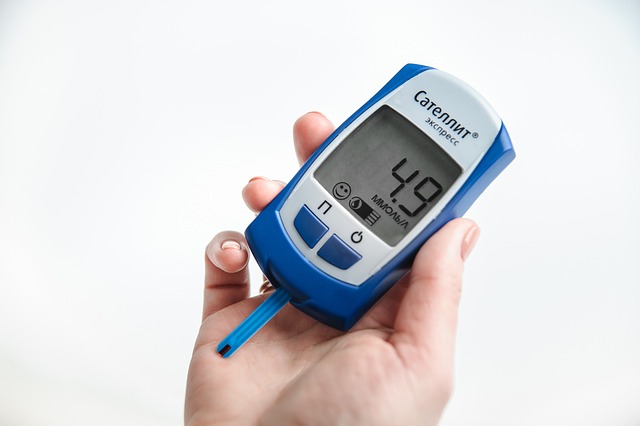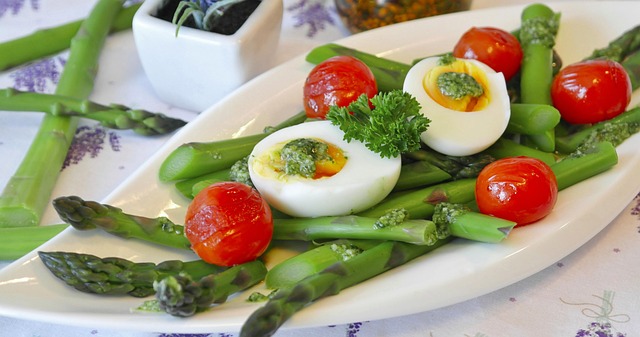As the Lark check-in mentioned, dietary fiber is a nutrient that helps control blood sugar, and oatmeal is one food that provides it. There are plenty of other nutrients that can help improve health and lower blood sugar. These are some of the best foods for preventing diabetes, as well as suggestions for how to add them to your diet. Mayo Clinic has many other healthy recipes to try, as well.
1 . Salmon

Like all fish, salmon is high in protein and free from carbohydrates. Linus Pauling Institute notes that salmon and other fatty fish are particularly healthy because they are rich in fat called omega-3 fats. These fats are good for your heart, brain, and blood pressure, and they may be good for your blood sugar. Salmon and other fatty fish are among the few natural sources of vitamin D, which you need for bone health.
For an easy meal, bake or grill salmon and serve it with lemon juice, dill, or low-sodium teriyaki sauce, plus brown rice or quinoa and a big helping of steamed, grilled, or roasted vegetables.
Expert tip: Mercury contamination can be a problem in fatty fish, but wild-caught or Atlantic salmon and canned pink salmon are safer choices. Sea bass, albacore and yellowfin tuna, orange roughy, and mackerel are higher in mercury.
2. Avocados

Avocados do not bump up your blood sugar much, since they are low in carbohydrates and high in dietary fiber. They are rich in monounsaturated fats, which, Mayo Clinic notes, are known for being a heart-healthy nutrient in Mediterranean diet patterns and which may improve insulin sensitivity. They have antioxidant vitamins E and C, and plenty of B vitamins, too.
Expert tip: Keep your portion size in check when you have avocados, since a small quarter-cup serving of mashed avocado has 90 calories. Also be aware of what you are having with your avocados, as a bowl of chips with guacamole is a very different choice than whole-grain toast with avocado, tomato slices, and an egg.
3. Spinach

Spinach is high in fiber as well as antioxidant vitamins A and C. It also has magnesium, which is necessary for healthy metabolism and improved insulin sensitivity. You can use spinach raw, such as in salads, or cooked into almost anything, including eggs, pasta dishes, and soups.
You really cannot go wrong when choosing green vegetables. Broccoli, kale, romaine lettuce, and celery are all low in calories and high in nutrients, and eating more vegetables may help promote a healthy weight, according to Harvard School of Public Health. Make salads or munch on raw vegetables with dip, or cook vegetables for sides or into stews or soups.
Expert tip: An ill-conceived salad can thwart the healthiest of intentions. Along with the greens, a good side salad might have other vegetables and a bit of dressing. A main course salad might have other vegetables, some lean protein such as chicken or garbanzo beans, an "extra" or two such as nuts or raspberries, and a bit of dressing. Beware of high-calorie add-ons such as croutons, too much dressing, chow mein noodles, bacon, and handfuls of cheese.
4. Oatmeal

Can you name a food that is nearly pure carbohydrate and yet helps prevent diabetes and lower risk for conditions such as high blood pressure, according to research published in the Journal of Food Technology? One such food is oatmeal. Oatmeal contains soluble fiber, which is the type that helps lower blood sugar and cholesterol, as well as B vitamins and iron. It also contains magnesium and another blood sugar-lowering nutrient: zinc.
Other whole grains can also be great choices, especially when you choose them instead of their refined-grain counterparts, according to Harvard Medical School. Whole-wheat bread, brown rice, whole-grain pasta, and unsweetened whole-grain breakfast cereals are all nutrient-rich and linked to lower diabetes risk.
Expert tip: Sprinkling cinnamon on your oatmeal can make it taste sweeter without adding calories or sugar. Plus, some evidence suggests that cinnamon can help lower blood sugar. Adding your own cinnamon and fruit is a far better option than flavored instant oatmeal with 10 or more grams of sugar per packet.
5. Reduced-fat yogurt.

Yogurt has a few carbohydrates, but not the type that shoot up your blood sugar, according to Harvard School of Public Health. It is high in protein and calcium, a mineral that improves bone health and may play a role in maintaining normal blood sugar levels.
Expert tip: Milk is required to be fortified with vitamin D, but yogurt and cheese may not. Check the label on yogurt to choose a brand that has vitamin D. The natural sugars in yogurt are nothing to worry about, but many types of flavored yogurt have 10 or more grams of added sugars per serving. To put that in perspective, that is the amount in half a Snickers bar.
6. Apples

If an apple a day keeps the doctor away, why change it? Apples are especially high in dietary fiber and they are low-glycemic, so they do not shoot your blood sugar levels up too much. Try them with peanut butter, nuts, or cheese to add some protein to your snack or meal.
Many other kinds of fruit are rich in fiber and have additional benefits. Oranges, grapefruit, and tangerines, for example, are especially low-glycemic. Berries are lower in sugar than some types of fruit, and cantaloupe is an excellent source of vitamins A and C. Vary your fruit and expand your health benefits.
Expert tip: Choose whole, fresh fruit or unsweetened frozen fruit when you can. Dried fruit is especially high in calories and sugar in just a small serving. Fruit juice is as high in calories and sugar as soft drinks, although richer in potassium, and it is low in fiber.
7. Acorn squash

Acorn squash is rich in fiber, vitamin A, and potassium, which is a particularly important nutrient for lowering blood pressure. Although it is a high-carbohydrate, consumption of acorn squash and other orange vegetables, such as sweet potatoes, carrots, and butternut and other types of winter squash, are linked to lower risk for type 2 diabetes.
Expert tip: Stuff half-baked acorn squash with lean ground turkey or a mixture of beans and cheese and bake it for a hearty main course. Or, try acorn squash as a healthier side dish than mashed potatoes.
8. Eggs

Eggs contain every essential vitamin and mineral except vitamin C, and are sources of heme iron, which is easier for your body to absorb than non-heme iron. They are also rich sources of selenium, which supports antioxidant activity in your body.
Try hard-boiled eggs for a snack or in salads, or have eggs for breakfast as an omelet or scrambled eggs. They go well with pretty much anything from fruit and whole-grain t
oast to cheese and vegetables.
Expert tip: Egg yolks have cholesterol and saturated fat, so it is better to stick to only one a day. Egg whites are nearly pure protein and low in calories, so if one egg does not feel you up, consider having one full egg plus a few egg whites for a bigger, more filling, protein-packed meal.
9. Pistachio nuts

Pistachio nuts are rich in vitamin B-6, which is necessary for nutrient metabolism and proper blood sugar control. They also have plant-based compounds, or nutrients, called phytosterols. These lower cholesterol levels in your blood.
All nuts are good choices, as they contain healthy fats, fiber, and protein, and are low in carbohydrates and unhealthy fats, according to Linus Pauling Institute. Almonds and peanuts are among the higher-fiber choices, while walnuts have omega-3 fats, and macadamias and hazelnuts top the charts in heart-healthy monounsaturated fats. Try them as a snack, in oatmeal, in salads, and in stir fry dishes.
Expert tip: Keep the serving size in check, as each 1-oz. serving of nuts or peanuts has about 200 calories. If you choose nut or peanut butter, be sure to choose an all-natural variety without added sugars or hydrogenated oils.
10. Water

Did you know that water itself is considered a nutrient? Even mild dehydration can lead to headaches, fatigue, and fogginess. A good baseline is 8 to 10 cups per day, plus more if you exercise or the weather is hot.
Water is calorie-free and naturally filling, making it an excellent choice for weight loss. You save 250 calories each time you choose water instead of a 20-oz. bottle of soda, fruit juice, or sweetened coffee beverages. Do that once a day, and you can lose a half-pound a week.
Expert tip: Try water at room temperature, chilled, or with ice to see what you like best. If you do not like plain water, try adding slices of lemon, cucumber, or strawberries, or add fresh mint or basil. Decaffeinated tea and coffee are good options, too.











.webp)






